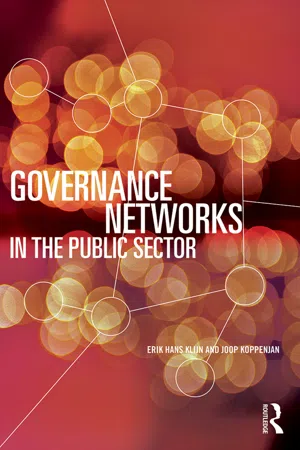
Governance Networks in the Public Sector
- 360 pages
- English
- ePUB (mobile friendly)
- Available on iOS & Android
Governance Networks in the Public Sector
About this book
Governance Networks in the Public Sector presents a comprehensive study of governance networks and the management of complexities in network settings. Public, private and non-profit organizations are increasingly faced with complex, wicked problems when making decisions, developing policies or delivering services in the public sector. These activities take place in networks of interdependent actors guided by diverging and sometimes conflicting perceptions and strategies. As a result these networks are dominated by cognitive, strategic and institutional complexities. Dealing with these complexities requires sophisticated forms of coordination: network governance.
This book presents the most recent theoretical and empirical insights into governance networks. It provides a conceptual framework and analytical tools to study the complexities involved in handling wicked problems in governance networks in the public sector. The book also discusses strategies and management recommendations for governments, business and third sector organisations operating in and governing networks.
Governance Networks in the Public Sector is an essential text for advanced students of public management, public administration, public policy and political science, and for public managers and policymakers.
Frequently asked questions
- Essential is ideal for learners and professionals who enjoy exploring a wide range of subjects. Access the Essential Library with 800,000+ trusted titles and best-sellers across business, personal growth, and the humanities. Includes unlimited reading time and Standard Read Aloud voice.
- Complete: Perfect for advanced learners and researchers needing full, unrestricted access. Unlock 1.4M+ books across hundreds of subjects, including academic and specialized titles. The Complete Plan also includes advanced features like Premium Read Aloud and Research Assistant.
Please note we cannot support devices running on iOS 13 and Android 7 or earlier. Learn more about using the app.
Information
1 Governance networks in the public sector An introduction
1.1 Introduction: governance networks as the answer to complexity
- Complex decision-making processes in relation to realizing, operating, and maintaining public infrastructural works (like railways, roads, airports, water projects, waste incinerators, power plants, and wind turbine parks) in which governments are confronted with a wide variety of stakeholders (private firms, citizens’ groups, other public actors, environmental interest groups, and so on).
- Restructuration processes of inner cities in which municipalities need to work together with non-profit organizations (like housing associations), private actors (developers) and citizens’ groups.
- Attempts at developing policies and achieving outcomes in fighting crime and improving social security that require coordinated efforts by various governmental organizations like the police, justice departments, emergency services, information bureaus, but also the involvement of private sector organizations and citizens, and collaboration between various layers of government and among nation states.
- Organizing integrated healthcare and social services for older people, which requires close cooperation between various health, welfare, social, and housing organizations that may be public, private, or non-profit, financed by, for instance, government or insurance companies.
- Processes of policy implementation or law enforcement, for instance in the food industry where governments try to regulate complex food production chains, in which various parties under conditions of competition may trade off food safety against other values.
- Processes aimed at preventing and managing large-scale accidents, crises, natural disasters, or large-scale social disturbances and their aftermaths, like the Hurricane Katrina disaster in New Orleans, the BP oil spill in the Gulf of Mexico, large-scale power blackouts, or outbreaks of epidemics like Ebola, that require coordination in order to create resilient networks.
Box 1.1 The debates on hydraulic fracturing as wicked problems
Box 1.2 Dealing with multiple problem clients in youth care as a wicked problem
1.2 Government, governance, and governance networks: a conceptual clarification
Government: the Traditional Public Administration Model
Table of contents
- Cover Page
- Half-Title Page
- Title Page
- Copyright Page
- Table of Contents
- List of figures
- List of tables
- List of boxes
- Preface
- 1 Governance networks in the public sector: an introduction
- PART I Governance networks
- PART II Network management
- PART III Normative issues in governance networks
- PART IV Synthesis and reflection
- References
- Index